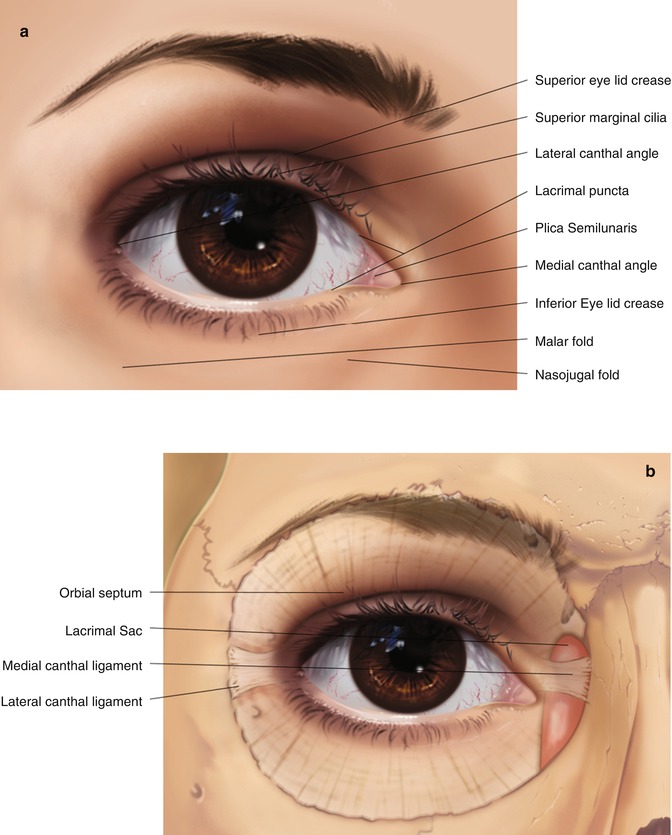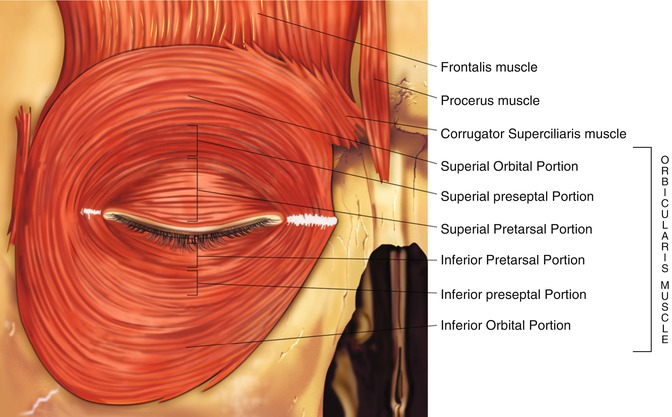(1)
Alo Eye Care, Kolkata, India
Keywords
Eyelid anatomyOrbicularis oculi muscleOrbital septumUpper lid retractorsLevator palpebrae superiorisMüller muscleLower lid retractorsSensory innervation eye lidMotor innervation eye lidLymphatic drainage eye lid1.1 Introduction
This chapter on the surgical anatomy of the eyelids covers the surface anatomy of the lid and periocular tissue. The lid is peeled anterior to posterior to show the layers that help form the eyelid. We then go a little deeper to get an idea of the structures in relation to the eyelid. We also look into the innervations and vascular supply of the lids. The aim of this chapter is to create a visual impression of the lid and the adnexal tissue during an actual surgical reconstructive procedure to solve the jigsaw puzzle following an eyelid tumor excision.
1.2 Surface Anatomy
The upper eyelid extends superiorly to the eyebrow. The lower lid extends below the inferior orbital rim to merge with the cheek, forming folds where the loose connective tissue of the eyelid is juxtaposed with the denser tissue of the cheek.
The upper eyelid skin crease (superior palpebral sulcus) is approximately 8–11 mm superior to the eyelid margin. It is formed by the attachment of the superficial insertion of levator aponeurotic fibers (8–9 mm in men and 9–11 mm in women).
The inferior eyelid fold (inferior palpebral sulcus), runs from 3 mm inferior to the medial lower lid margin to 5 mm inferior to the lateral lid margin.
The nasojugal fold runs inferiorly and laterally from the inner canthal region along the depression of separation of the orbicularis oculi and the levator labii superioris, forming the tear trough. It runs inferiorly and medially from the outer canthus toward the inferior aspect of the nasojugal and malar folds.
The open eye presents the palpebral fissure, a fusiform space between the lid margins that is 28–30 mm in length and about 9–10 mm in maximal height. The natural curvature of the upper lid is a function of the static shape of the tarsus combined with adaptation of the lid to the curvature of the globe. In the normal adult, the highest point of the upper lid is situated approximately 2 mm below the upper limbus. The lower eyelid margin rests at the level of the lower limbus. The lateral canthal angle is 2 mm higher than the medial canthal angle in Europeans; it is 3 mm higher in Asians. The distance from the medial canthus to the midline of the nose is approximately 15 mm.
The palpebral fissure presents the lateral canthus (an angle of 30–40° approximately 5 mm from the lateral orbital rim), the medial canthus (forming the medial angle of the fissure, with the upper border passing inferomedially and the lower border horizontally), and the lacrimal papillae, which rest on the free lid margin, with the punctum lacrimale serving as an opening to the canaliculus (Fig. 1.1a).


Fig. 1.1
Surface anatomy of (a) the eyelids and periorbital region and (b) the eye in relation to the bony orbit
1.3 Overview of Structure
Structures that should be considered in the description of eyelid anatomy include the skin and subcutaneous tissue, orbicularis oculi muscle, submuscular areolar tissue, fibrous layer consisting of the tarsi and the orbital septum, lid retractors of the upper and lower eyelids, retroseptal fat pads, and conjunctiva.
1.4 Skin and Subcutaneous Tissue
The skin of the eyelids is the thinnest of the body (<1 mm). The nasal portion of the eyelid skin has finer hairs and more sebaceous glands than the temporal aspect, making this skin smoother and oilier. The transition from this thin eyelid skin to the thicker skin of the eyebrow (approximately 10 mm below the lower eyebrow hairs) and the cheek skin (below the nasojugal and malar folds) is clinically evident. These boundaries should be considered in reconstructive eyelid surgery. The subcutaneous tissue consists of loose connective tissue.
Fat is very sparse in preseptal and preorbital skin and is absent from pretarsal skin. Subcutaneous tissue is absent over the medial and lateral palpebral ligaments, where the skin adheres to the underlying fibrous tissue. Dermatochalasis, blepharochalasis, and epicanthic folds all are conditions that primarily involve the skin and subcutaneous tissue of the eyelids (Fig. 1.1b).
1.5 Orbicularis Oculi Muscle
The orbicularis oculi muscle is one of the superficial muscles of facial expression. Invested by the superficial musculoaponeurotic system (SMAS), muscle contracture is translated into movement of the overlying tissues by the fibrous septa extending from the SMAS into the dermis.
1.5.1 Parts
The muscle may be divided arbitrarily divided into the
orbital part
palpebral part, which is divided further into the
preseptal portion
pretarsal portion
1.5.2 Function
The palpebral portion is used in blinking and voluntary winking. The orbital portion is used in forced closure.
1.5.3 Innervation
Facial nerve innervation is from the temporal branches and from the zygomatic branches of the facial nerve. The nerves are oriented horizontally and innervate the muscle from the undersurface.
1.5.4 Origin and Insertion
The orbital portion extends in a wide circular fashion around the orbit, integrating with other muscles of facial expression. It has a curved origin from the medial orbital margin, and is attached to the superomedial orbital margin, maxillary process of the frontal bone, medial palpebral ligament, frontal process of the maxilla, and inferomedial orbital margin. Fibers from this medial origin sweep around the orbital margin in a horseshoe fashion. The muscle fibers extend superiorly to intermix with the frontalis muscle and corrugator supercilii muscle laterally, to cover the anterior temporalis fascia, and inferiorly, to cover the origins of the lip elevators.
The preseptal orbicularis muscles overlie the orbital septum and originate medially from a superficial and deep head associated with the medial palpebral ligament. The fibers from the upper and lower lids join laterally to form the lateral palpebral raphe, which is attached to the overlying skin.
The pretarsal portion lies anterior to the tarsus, with a superficial and deep head of origin intimately associated with the medial palpebral ligament. Fibers run horizontally and laterally to run deep to the lateral palpebral raphe to insert in the lateral orbital tubercle through the intermediary of the lateral canthal tendon (LCT).


Fig. 1.2
Orbicularis oculi muscle
1.6 Submuscular Areolar Tissue
Submuscular areolar tissue consists of variable loose connective tissue below the orbicularis oculi muscle. The lid may be split into anterior and posterior portions through this potential plane, which is reached by division at the gray line of the lid margin. In the upper lid, this plane is traversed by fibers of the levator aponeurosis, some of which pass through the orbicularis to attach to the skin to form the lid crease. In the lower eyelid, this plane is traversed by fibers of the orbitomalar ligament. Superior continuance in this submuscular plane arrives at the retro-orbicularis oculi fat (ROOF), which is best developed in the eyebrow region. Additionally, the suborbicularis oculi fat is found in the lower lid in a continuance of this plane.
1.7 Tarsi and Orbital Septum
1.7.1 Tarsal Plates
The tarsal plates are composed of dense fibrous tissue and are responsible for the structural integrity of the lids.
Each tarsus is approximately 29 mm long and 1 mm thick. The crescentic superior tarsus is 10 mm in vertical height centrally, narrowing medially and laterally. The lower border of the superior tarsus forms the posterior lid margin. The rectangular inferior tarsus is 3.5 and 5 mm high at the eyelid center. The posterior surfaces of the tarsi adhere to conjunctivae.
Stay updated, free articles. Join our Telegram channel

Full access? Get Clinical Tree


